Photography Industry Trends 2024: What’s Shaping the Future?
Welcome to the 2024 Photography Industry Trends Report.
What are the most popular genres of professional photography? How many images do they deliver to each client, and how long do they take to deliver them?
If you want answers to these questions and more, then you’ll want to dive into this 2024 photography industry report.
The photography industry continues to evolve rapidly, driven by technological advancements, changing client expectations, and shifting market dynamics. This comprehensive report, based on a survey of hundreds of professional photographers, offers deep insights into the current state of the industry, emerging trends, and opportunities for growth and innovation.
Quick disclaimer, before we begin...
This survey primarily reflects the perspectives of established photographers who have developed their careers and are earning substantial income from photography. The data is particularly relevant to wedding, portrait, and event photography, which emerged as the top three specialties among respondents.
Readers should interpret these results as representative of experienced, working photographers, especially those in the wedding, portrait, and event niches. While providing valuable insights into these areas, the report may not fully capture the experiences of emerging photographers or those specializing in other genres of photography.
Summary
We surveyed over 500 professional photographers from different industries and found:
- 50.6% started as a hobby during childhood or early teens
- 46.9% capture 1,000 - 3,000 images per shoot
- Only 13.4% deliver in less than a week
- Only 6.3% spend more than $5,000 on photography equipment
But that’s just the tip of the iceberg. Follow along as we delve deeper into the insights we gathered from our survey.
Demographics: The Changing Face of Professional Photography
Age Distribution: Experience Dominates the Field
The age distribution of photographers reveals an industry largely driven by mid-career professionals.

- The industry is dominated by experienced professionals, with 70.6% of photographers aged 35-60.
- The 25-35 and 45-60 age brackets each represent 25.8% of professional photographers, indicating a balanced distribution between early-career professionals and more seasoned practitioners.
- The concentration of mid-career professionals suggests a highly competitive market where experience and established networks play crucial roles.
What This Means for Photographers
Not being a “conventional” career, photographers often turn their hobby into a full time job later in their lives. Still, the fact that 25.8% of the respondents fell into the 25-35 age bracket means that the age gap is decreasing. The data also suggests that photography as a profession attracts and retains individuals across a wide age spectrum, offering opportunities for both newcomers and experienced professionals alike.
Opportunities
- Experienced photographers should consider mentorship programs to pass on knowledge.
- Industry organizations could develop initiatives to attract younger photographers.
- Young photographers can leverage their unique perspective as a differentiator in the market.
Photography Genres & Specializations: Weddings Take the Lead
While wedding photography dominates (86.5%), the high percentage of photographers engaged in portraits (69.8%) and events (47.1%) reveals that many photographers are diversifying their services.

The relatively low percentages in specialties like boudoir (13.4%) and real estate (8.8%) suggest untapped markets. Notably, 16.6% of respondents mentioned other specializations, including newborn, corporate, and commercial photography, as well as niches like funeral photography and dance performances — which indicates potential for highly specialized services.
What This Means for Photographers
Wedding photography's dominance indicates its position as a cornerstone of the industry, but also suggests market saturation. The high engagement in portraits and events shows photographers are diversifying to create multiple revenue streams.
Niche markets such as newborn, corporate, and pet photography offer opportunities for specialization and differentiation.
Opportunities
- Wedding photographers may want to consider expanding into related fields like portraits and events.
- Explore niche markets, and develop skills in multiple areas to create unique service packages.
Career Pathways: How Professional Photographers Got Where They Are Now
Getting Started in Photography: Passion Drives Professional Pursuits
The data reveals diverse pathways into professional photography, with passion being a key driver.
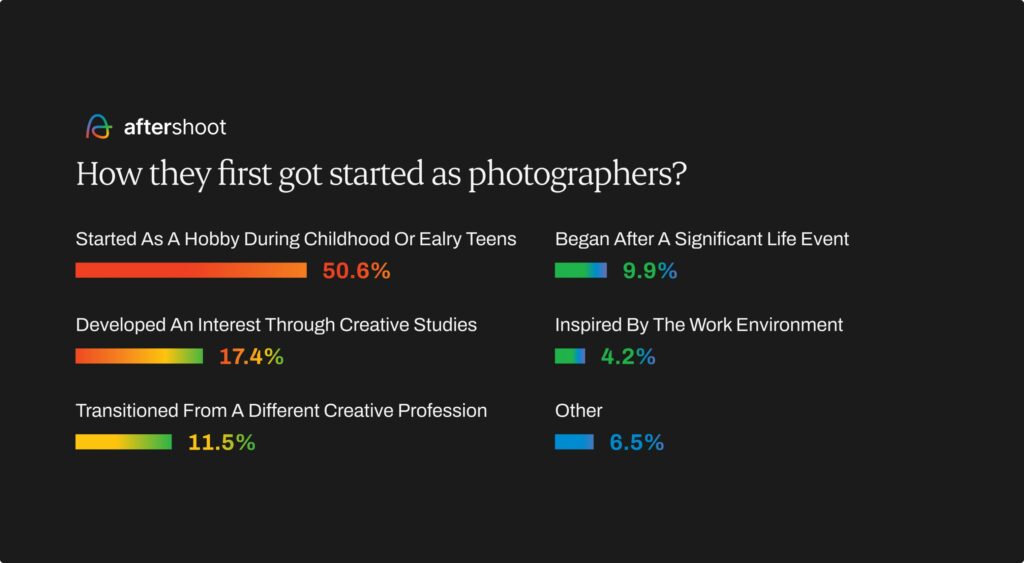
- 50.6% started as a hobby during childhood or early teens
- 17.4% developed interest during college
- 11.5% transitioned from related visual or creative work
What This Means for Photographers
Photography as a career is accessible to those with diverse backgrounds and experiences. Many decide to turn their passion into a career, both early during their education and later in their careers. Many responses revealed fascinating pathways into professional photography, from former military careers to transitions from corporate roles, showcasing the industry's accessibility.
There is no true “career ladder” to become a photographer, except for purely chasing experience.
Opportunities
- Leverage your unique background as a storytelling element in your brand.
- Consider creating content or workshops that help others transition into photography.
- Network with professionals from diverse fields to gain fresh perspectives.
- Several responses mentioned photography as a way to combat depression or find purpose, suggesting an opportunity for programs that promote photography as a therapeutic or life-changing pursuit.
Learning Photography: Self-Direction and Practical Experience Dominate
The survey shows a strong trend towards self-directed learning and hands-on experience.
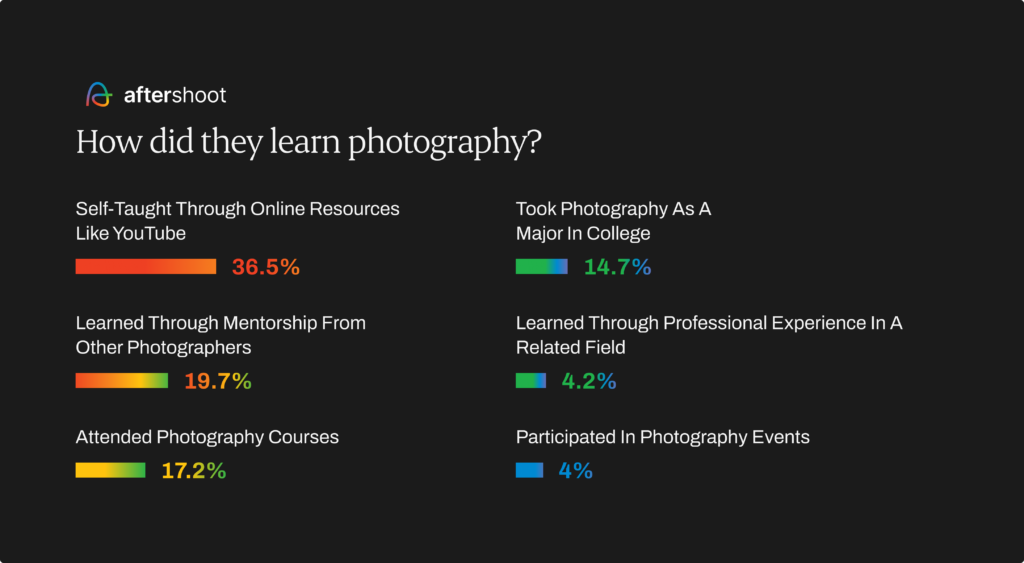
- 36.5% are self-taught through online resources
- 19.7% learned through hands-on experience and mentorship
- 17.2% attended photography courses
What This Means for Photographers
Continuous, self-directed learning is crucial. While most photographers teach themselves, through pure practical experience and YouTube videos, many also look towards mentorship opportunities and industry connections.
Formal education still plays a significant role, suggesting a market for structured, comprehensive photography education.
Opportunities
- Invest in high-quality online courses and workshops to continually upgrade skills.
- Seek mentorship opportunities or consider becoming a mentor.
- Balance theoretical knowledge with practical experience through personal projects or assisting established photographers.
Working Styles and Workflows of Professional Photographers
Image Capturing & Culling: High-Volume Shooting is the Norm
Photographers are capturing a large number of images per session, necessitating efficient workflows.

- 46.9% capture 1,000 - 3,000 images per shoot
- 36.8% capture 3,000 - 6,000 images
- 12.4% capture 6,000 - 10,000 images
What This Means for Photographers
High-volume shooting necessitates efficient culling and storage solutions. The trend towards capturing thousands of images may impact equipment choices, focusing on cameras with high burst rates and large storage capacities.
This approach suggests a "spray and pray" mentality, which could be addressed through more targeted shooting techniques.
Opportunities
- Invest in high-speed storage solutions and robust backup systems.
- Adopt AI-powered culling tools to streamline the selection process.
- Refine shooting techniques to capture more intentional shots, potentially reducing overall volume.
Image Editing & Delivery: Balancing Quantity and Quality
The number of delivered images varies widely, with most photographers delivering between 500-1000 images.

- 43.9% deliver 500-1000 images
- 18.9% deliver 1,000 - 3,000 images
- 16.2% deliver 200-500 images
What This Means for Photographers
The survey indicates a significant culling and editing process from capture to delivery. The wide range in delivery numbers (from under 100 to over 3,000) also suggests varied client expectations and photographer styles. Finding the right balance between quantity and quality will be crucial for client satisfaction and workflow efficiency.
Opportunities
- Clearly communicate delivery expectations with clients before the shoot.
- Consider offering tiered packages with different quantities of delivered images.
- Focus on delivering a curated selection of high-quality images rather than sheer volume.
Turnaround Time: Balancing Speed and Quality
Most photographers take several weeks to deliver final edited images, with a minority offering rapid turnaround.
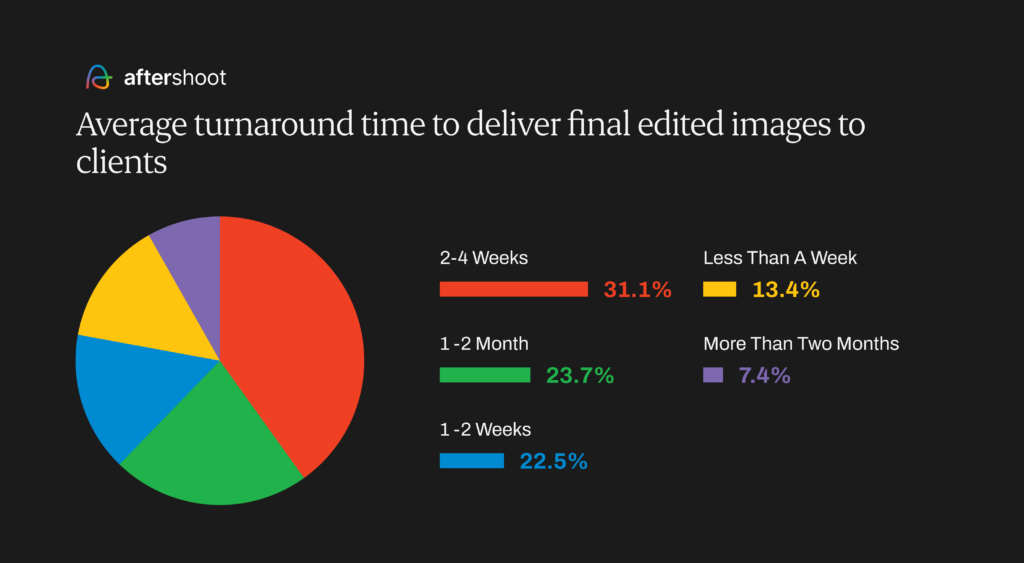
- 31.1% deliver in 2-4 weeks
- 23.7% take 1-2 months
- Only 13.4% deliver in less than a week
What This Means for Photographers
The majority delivering in 2-4 weeks suggests this is an industry-standard, useful for setting client expectations. Only 13.4% delivering in less than a week indicates a potential niche for rapid turnaround services as a unique selling point.
Longer turnaround times may indicate complex post-processing or high workloads, suggesting a need for more efficient workflows.
Opportunities
- Implement a streamlined post-processing workflow using AI tools and presets.
- Offer tiered services with different turnaround times and pricing.
- Communicate clearly with clients about expected delivery times to manage expectations.
Working in Teams: The Rising Role of Second Shooters
Many photographers work with second shooters, adapting their approach based on the event's needs.
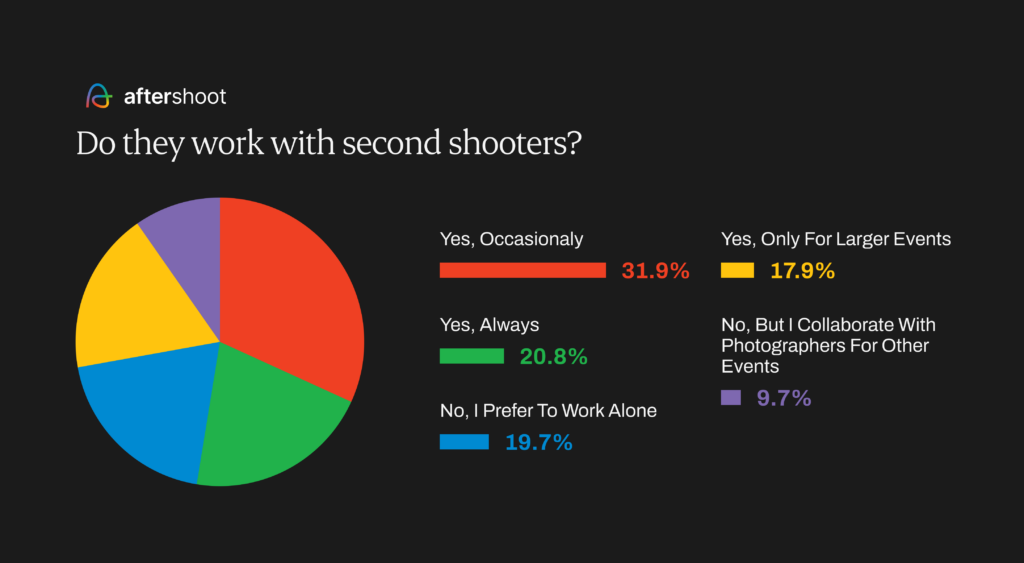
- 31.9% work with second shooters occasionally
- 20.8% always use second shooters
- 19.7% prefer to work alone
What This Means for Photographers
Flexibility in team composition can help photographers adapt to different project requirements.
Opportunities
- Build a network of reliable second shooters for larger events.
- Develop clear workflows and communication systems for collaborating with second shooters.
- For solo photographers, focus on equipment and techniques that maximize efficiency when working alone.
Marketing Strategies: How Photographers Leverage Digital and Traditional Channels to Market Themselves
Social media and word-of-mouth referrals dominate marketing strategies, with digital channels playing a crucial role.
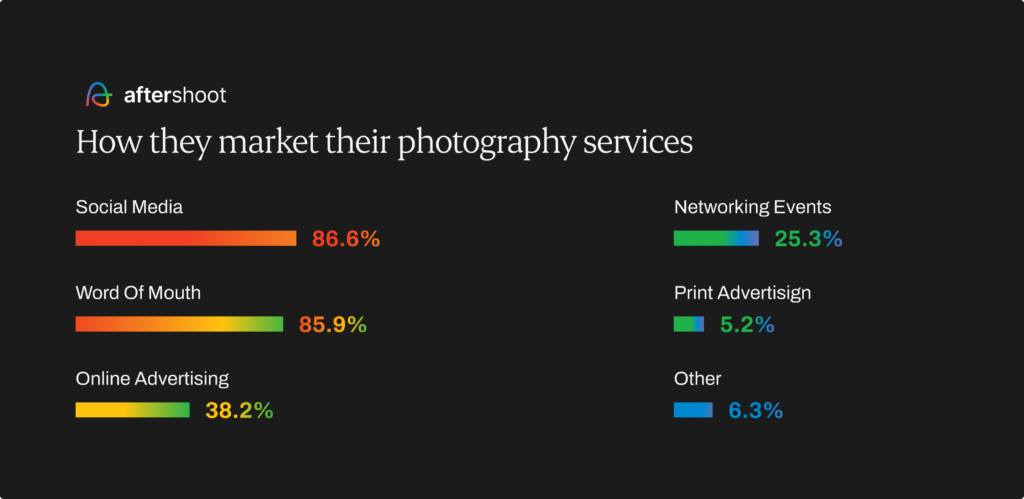
- 86.6% use social media for marketing
- 85.9% rely on word-of-mouth referrals
- 38.2% use online advertising
- Many photographers mention “SEO” and Google Search as their main promotion channels.
What This Means for Photographers
A strong online presence coupled with excellent client relationships is crucial for success.
There is still a high reliance on word-of-mouth, emphasizing the importance of client satisfaction and relationship building.
SEO and Google search results are also growing in importance as a marketing strategy adopted by professional photographers.
Opportunities
- Develop a comprehensive social media strategy, starting with one platform and later expanding across multiple platforms.
- Consider implementing a referral program to incentivize word-of-mouth marketing.
- Invest in targeted online advertising to reach specific client demographics.
- Consider SEO optimization for your website.
- Several responses mentioned preferred vendor lists, suggesting an opportunity for photographers to develop strong relationships with venues.
Gear and Budgeting: Investing in Your Craft
Preferred Gear Brands: Diversity in Equipment Choices
Photographers use a wide range of equipment brands, with some clear leaders in the market.

- Canon (50.2%) remains the dominant choice among photographers, with Nikon (29.2%) still holding a notable market share. However, Sony (26.9%), a later entrant in the photography space, has quickly gained traction by pushing the boundaries of mirrorless technology, growing faster than the long-established brands Canon and Nikon.
- Godox's popularity (51.7%) indicates a trend towards cost-effective lighting solutions.
- The responses also revealed a demand for specialized gear, from Leica cameras to Holdfast straps, showing photographers' willingness to invest in niche, high-quality equipment.
Annual Budget for Gear & Tools: Cautious Investment Strategies
Most photographers maintain modest annual budgets for photography gear and tools.
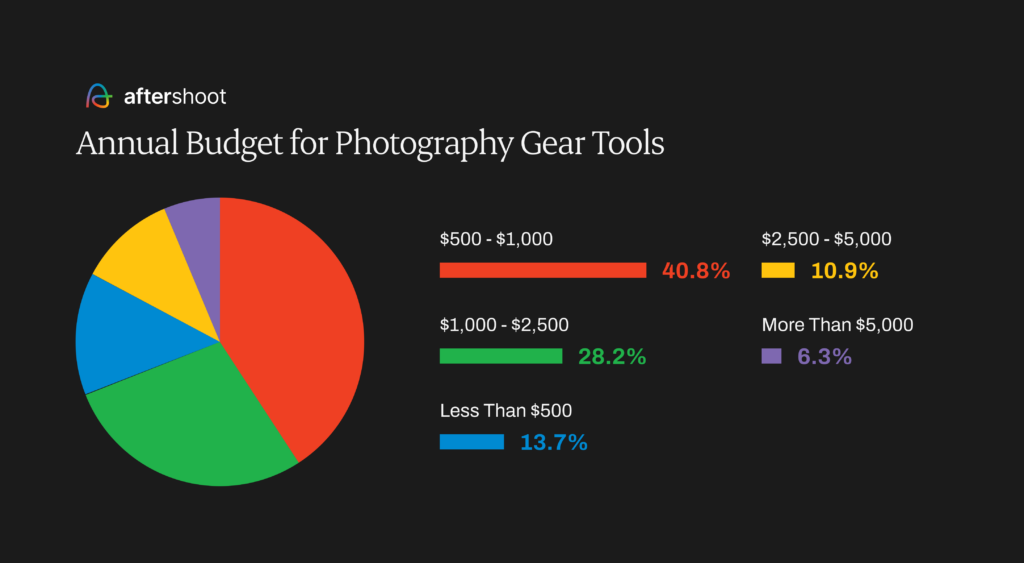
- 40.8% budget $500 - $1,000 annually
- 28.2% budget $1,000 - $2,500
- Only 6.3% spend more than $5,000
What This Means for Photographers
Survey results reveal conservative budgeting and careful investment strategies among photographers, with only 6.3% spending over $5,000 annually.
This spending pattern suggests a focus on maximizing existing equipment rather than constantly upgrading.
Opportunities
- Develop a long-term gear acquisition strategy aligned with your business goals.
- Invest in versatile gear that can serve multiple purposes to maximize your budget.
Industry Influences and Resources
Preferred Media Outlets: Aspiring for High-End Recognition
Many photographers aspire to be featured in prestigious publications, particularly in the fashion and wedding industries.
- 9.92% mentioned Vogue as a desired feature
- 7.06% are interested in wedding-related magazines/blogs
- 4.58% mentioned Brides Magazine
Newsletter Subscriptions: Information Overload or Lack of Relevance?
A significant number of photographers don't engage with industry newsletters, while others focus on specific sources.
- 28.62% don't read any photography-related newsletters
- 5.15% are subscribed to the Professional Photographers of America (PPA).
- 3.24% follow gear-specific newsletters.
- 3.05% of photographers mentioned Aftershoot’s very own newsletter, the Aftershoot Digest!
Opportunities and Next Steps
- Curate a personal list of high-value information sources to stay informed without overwhelming yourself.
- Consider creating your own newsletter or content to fill gaps in the market.
- Engage with peer networks and forums for real-time industry insights.
Influential Photographers: Learning from Industry Leaders
When asked, photographers happily mentioned trusted leaders in the photography industry who they look up to and whose style they love. While there were too many names to mention, we took the liberty to find out the top 5 names that came up in the responses.
- Sam Hurd (Tune in to our podcast episode with him!)
- Jose Villa
- Esteban Gil (Edit like Esteban on Aftershoot)
- Two Mann Studios
- Ben Hartley
The photography industry in 2024 is characterized by rapid technological advancement, changing client expectations, and the constant need to adapt. Successful photographers will be those who can efficiently manage high-volume workflows, maintain creative distinction, and effectively market themselves in a digital-first world.
The photography industry trends report emphasizes these key areas to focus on:
- Embracing AI and automation not just for basic tasks, but as a tool to enhance creativity and consistency.
- Diversifying skill sets across multiple photography genres for more stability and opportunities.
- Building a strong online presence by mastering social media and SEO to boost visibility and client acquisition.
- Continuous learning and innovation to stay competitive in the dynamic market.
- Efficient workflow management to streamline processes from capture to delivery.
- Cautious gear investment with interest in specialized equipment.
We hope you found this industry report as useful as we did! Keep an eye on this space for more original research from us on the state of the photography industry.
Photography Industry Trends Report by Aftershoot
The photography industry trends report is brought to you by Aftershoot, a leading AI culling and editing tool that helps photographers streamline their post-production workflow. Our tool has empowered thousands of photographers to do more with their time.
Aftershoot was started by the drive to make the lives of photographers easier through technology. Our users are the primary driving force behind Aftershoot. We wouldn't be where we are if it wasn’t for the continuous feedback and support we received from the creative community, and we're committed to giving back.
